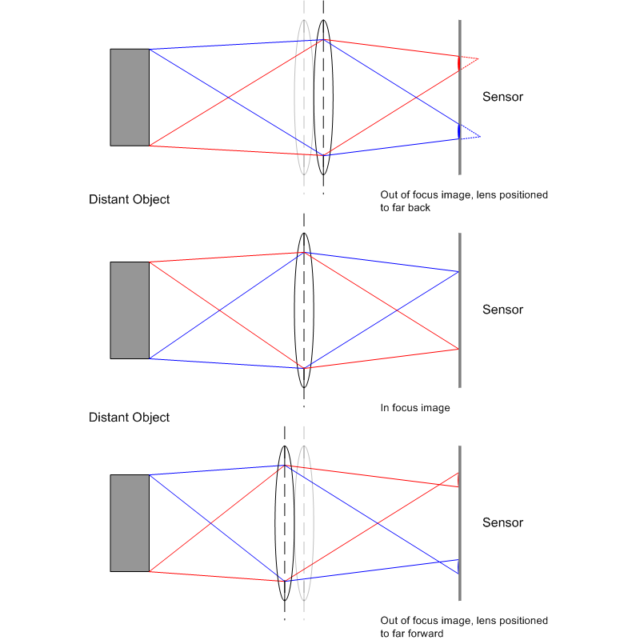I was working on a new series about the history of focusing and focus aids when I looked outside and saw this the sky was turning simply amazing colors. Unfortunately, it was too late to go find a foreground worth including, but I wasn’t about to pass up the shot at the colors.
I’m in the process of writing a rather long essay on the evolution of focusing and focusing aids from ground glass to contrast detection, and everything in between. It’s probably going to be a while before I get that finished and this was interesting enough that I thought it warranted an aside.
Nikon has filed for a patent on a mechanism to embed what amounts to auto focus pixels in the imaging sensor itself. This would in affect solve the performance issues contrast detection autofocus poses.
A bit of background, contrast detection AF systems suffer from a number of limitations that prevent them from matching the speed of the simpler phase detection systems. There are three main problems that contrast detection systems need to overcome. First is pixel sensitivity, because the camera is using information from the imaging pixels, it’s not possible to tune the the autofocus pixels to be more sensitive to light. This means that the camera makes more of a trade off in autofocus speed as light levels drop.
The second issue is it’s nearly impossible to tell which direction the image should be shifted without performing very complicated image analysis on other parts of the image, and even then there’s no guarantee that will be right. This is because to the imaging pixels a front or back focused lens simply produces a diffuse blob.

The final problem is the required processing power. In a contrast detection AF system the camera’s processor is actually trying to quantitatively find the point where to pixels have the highest different in brightness. A phase detection system simply compares the brightnesses of each pixel in two different rows of pixels. In an in-focus image they two rows of pixels will be the same, in an out of focus image they won’t line up.
What it appears Nikon is doing is miniaturizing the optical path of prisms and lenses that feed our current phase detection sensors and embedding them in the actual imaging sensor in place of imaging pixels where they want the auto focus point to be. This givens a camera using this system all the speed and efficiency benefits of phase detection without requiring a mirror or other beam splitter to direct some light away from the sensor.
None of these problems apply to a phase detection system. Because of the way the prisms bend light the direction that the lens needs to be focused is already known (except in the case of a severe defocus situation). In addition the specialize pixels used in the AF array can be tuned to be sensitive at much lower light levels while maintaining a good signal to noise ratio so they can be read quickly. Finally, processing is almost a non-issue thanks to the limited number of pixels the actual operation being performed on them.
The only possible problem is that the camera has to interpolate image data to cover up the holes the autofocus pixels leave. But truthfully that’s probably not much of a problem at all. Cameras current map out defective pixels and replace their measured values with interpolated values from the surrounding pixels. Even the basic Bayer layout of the sensor requires interpolation to turn the RAW data coming out of the sensor into something we can understand as a picture.
What it ultimately boils down to is this could give a point and shoot the same AF performance SLRs have. Of course if you pair this with another Nikon patent for what looks like an interchangeable lens camera in the Olympus E-P1 style, you might be able to start putting together an image of what Nikon has in store for us in the future. One thing that’s clear this patent has the potential to close the performance gap between Point and Shoots and SLRs, and pave the way for a mirror free/prism free SLR that can maintain current autofocus performance levels.
The patent in question is number 2009016727.
I’ve always liked clouds, not normal clouds but big cumulonimbus clouds. Especially when they’re back-lit in the morning or late afternoon. Abstract in nature, often with interesting lighting and tonalities and always impressive in scale. On that note, I shot these of a brewing storm a couple of weeks ago.
 Today concluded round 2 of serious focus testing. What’s different this time from the last? A new target, a new alignment strategy, and some new results. Last time I looked at autofocus, I had enough problems focusing fast lenses that I was growing concerned that there was either a systematic design flaw or similar error in phase detection AF systems. I was seeing behavior with fast lenses on both Canon and Nikon bodies that would inconsistently focus depending on a verity of situations.
Today concluded round 2 of serious focus testing. What’s different this time from the last? A new target, a new alignment strategy, and some new results. Last time I looked at autofocus, I had enough problems focusing fast lenses that I was growing concerned that there was either a systematic design flaw or similar error in phase detection AF systems. I was seeing behavior with fast lenses on both Canon and Nikon bodies that would inconsistently focus depending on a verity of situations.
The good news, the new target dramatically improved auto focus consistency on both platforms and the new alignment strategy shortened setup time and aided accuracy. The not so good news is that I’ve determined that there is definitely a problem with my EF 50mm f/1.8 II and it may in fact be a much wider issue; though I guess you could say, what do you expect from a $100 lens.
I just finished up helping a fellow photographer and friend setup and calibrate his new Dell 2407WFP LCD display and yet again I am reminded how much I really hate dealing with color and color profiling.
What settings should you use to calibrate your display?
In Michael Reichmann’s From Camera to Print, Jeff Schewe comments that instead of specifying the traditional D65 white point and gamma-2.2 you should simply profile your display at the native white point and gamma. The argument being that because the video processing chain (i.e the OS, video card, and monitors) are 8-bit the extra translation step forcing D65 and a specific gamma requires can actually create or increase errors in color.
Syl Arena, over at www.pixsylated.com recently put up a Canon Speedlite Wishlist. Syl gives us 17 points to chew on that he thinks would make Canon’s Speedlite system better; most of which I agree with, some I think are silly, and some I think are a bad idea in the larger scheme of things. However, in that spirit here are my thoughts, however little they may count, and my Canon Speedlite Wishlist.
My Wish-list
- Replace the power switch and slave mode button with a single multi-position power switch (off, solo, master, slave)
- Get rid of ratios for wireless groups, use straight exposure compensation for all of the 3 groups.
- Insure that every flash has proper EMI shielding
- More zoom, so long as it doesn’t make the flash bigger
- Replace the ST-E2 with something that exposes the full functionality of the system
- Replace the MR-14 and MT-24 with something more flexible and modular
- Open or license the TTL protocol to the wireless remote manufacturers
The fourth of July, Independence day in the USA. The one time per year I get to photograph serious firework displays with out having to travel out of my way or fight crowds. The only disadvantage, there’s never a foreground to speak up, which makes the images a lot less interesting.
However, it does have it’s advantages in a more abstract sense. With out foregrounds to worry about I can concentrate on composing abstract firework streaks.

As always preparation is key, and I have my camera’s setup and on their tripods long before the show even starts. My exposure is dialed in (manual mode), the lenses are focused to infinity and the AF/MF switches are set to manual, film speed is set, new CF cards are loaded and formatted, cable releases attached, etc.. Further I have a good idea of where I may want to place my camera or cameras before it gets completely dark. I tend to shoot two cameras, a Show camera and my primary camera. My show camera shoots continuously though the show, providing an overview of everything that happened. My primary camera, has me at the helm trying to intelligently compose images, or at least try not to make mess of things.

It’s that time of year again, the Northern Mockingbirds that nested a month or two ago are now in the “mommy feed me” stage.

Unfortunately for me this one has been sitting outside of my window but not somewhere I could be photographed all day, peeping continuously.

Professionals and serious amateur photographers alike know that lens hoods are an important part of the lens. A properly designed lens hood shades the lens’s front element or protective filters, from stray non-image producing light. The stray light can bounce around inside the lens and reduce contrast as well as create flare (if sufficiently close to the lens’s field of view).
Lens hoods help to minimize those effects, but they have to be designed for the lens’s field of view. However currently many photographers are using smaller crop sensors with lenses with lens hoods designed for 135 format film. For example, the Canon EF 28-135 f/3.5-5.6 IS USM that comes as part of one of the Canon 50D kits, was designed to be used with a camera with a 35mm film size frame. As such the lens hood is designed to shade the field of view of a 28mm lens when there is a 35mm frame behind it. But on the 50D, the lens at 28mm has a much narrower field of view, in fact it’s equivalent to a 45mm lens on a full frame camera. In this case you can shade more of the lens with out vignetting showing in the image.
Anyway in the link below, David Burren has put together a table of possible alternate lens hoods for use on EF lenses when used on APS-C (1.6 crop) and APS-H (1.3 crop) Canon bodies. Keep in mind, not all lenses can be adapted, so if your lens isn’t in the list, it’s quite possible there isn’t an alternative hood available for it. Also note, EF-S lenses and lenses designed for crop format digital bodies (like Sigma’s DC line) have lens hoods designed to shade the lens as much as possible on a crop format body.
It’s been the dream of serious digital photographers for a long time now, a small digital system with interchangeable lenses, near SLR image quality and a pocketable design.
The first real attempt at a “pro P&S” could be the Sigma DP1. Its large SLR sized (1.7x crop) sensor produced amazing images behind the fixed 16.6mm f/4 (28mm equivalent) lens. Sigma continued the DP series with the DP2, taking the same sensor and placing it behind a 24.2mm f/2.8 (41mm equivalent) fixed lens. But neither quite answered the call for a interchangeable lens pro level P&S.
Until now.




